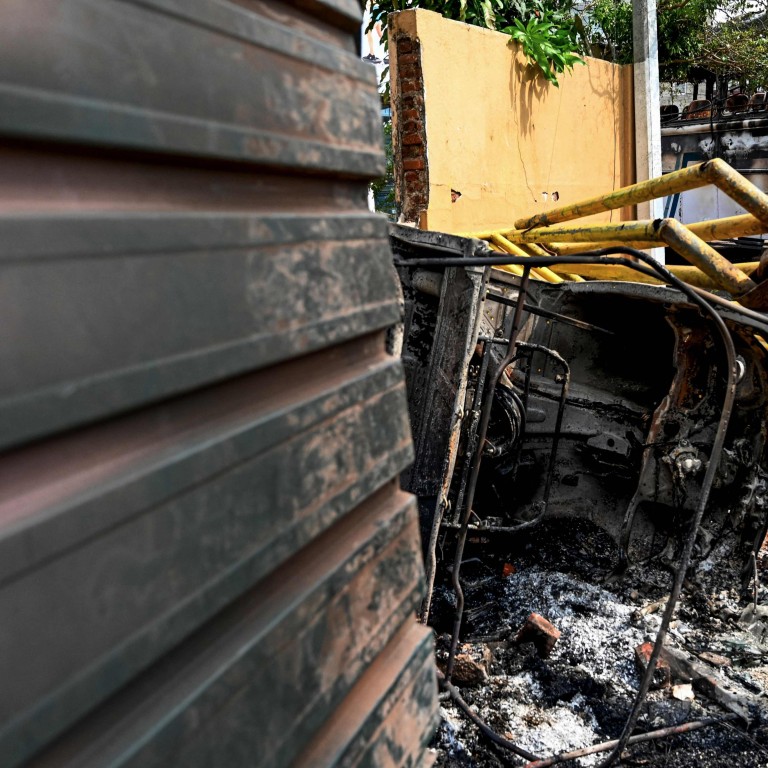
Sri Lanka declares state of emergency as street protests spread amid unprecedented economic crisis
- Emergency declaration provides security forces with sweeping powers allowing military to arrest and detain suspects for long periods without trial
- Protesters want the president to resign amid an unprecedented economic crisis that led to severe shortages of essentials, sharp price rises and power cuts
Sri Lanka’s president declared a state of emergency on Friday giving sweeping powers to security forces a day after hundreds tried to storm his house in anger over an unprecedented economic crisis.
President Gotabaya Rajapaksa invoked the tough laws allowing the military to arrest and detain suspects for long periods without trial as demonstrations calling for his ouster spread across the South Asian nation.
The emergency was declared for “protection of public order and the maintenance of supplies and services essential to the life of the community,” he said in a proclamation.

Police arrested 53 people and imposed a curfew in and around Colombo on Friday to contain sporadic protests that have broken out over shortages of essential items, including fuel and other goods.
The Indian Ocean island nation of 22 million people faces rolling blackouts for up to 13 hours a day as the government scrambles to secure foreign exchange to pay for fuel imports.
Earlier in the evening, dozens of rights activists carried handwritten placards and oil lamps in the capital while demonstrating at a busy intersection.
Sri Lanka’s all-powerful Rajapaksas family under fire
“Time to quit Rajapaksas,” said one placard. “No more corruption, go home Gota,” said another – referring to the president.
In the highland town of Nuwara Eliya, activists blocked the opening of a flower exhibition by Prime Minister Mahinda Rajapaksa’s wife, Shiranthi, police said.
The southern towns of Galle, Matara and Moratuwa also saw anti-government protests, and similar demonstrations were reported in the northern and central regions. All held up traffic on main roads.
Thursday night’s unrest outside the president’s private home saw hundreds of people demand he step down.

People chanted “lunatic, lunatic, go home”, before police fired tear gas and used water cannon.
The crowd turned violent, setting ablaze two military buses, a police jeep, two patrol motorcycles and a three-wheeler. They also threw bricks at officers.
At least two protesters were wounded. Police said 53 protesters were arrested, but local media organisations said five news photographers were also detained and tortured at a local police station, a charge the government said it will investigate.
The police and military presence was strengthened on Friday.
As struggling Sri Lanka casts around for cash, its China ties loom large
Two government ministers said a major intelligence failure had placed the lives of the president and his wife in danger on Thursday.
“Both the president and his wife were at their home when the protests were going on,” Health Minister Keheliya Rambukwella told reporters in Colombo, discounting earlier claims that they were away at the time.
“We had information of a demonstration, but nothing suggesting that it could turn violent. This is a major intelligence failure.”
Transport Minister Dilum Amunugama said “terrorists” were behind the unrest.
Sri Lanka bolsters security after violent protests over economic crisis
Rajapaksa’s office said on Friday that the protesters wanted to create an “Arab spring” – a reference to anti-government protests in response to corruption and economic stagnation that gripped the Middle East more than a decade ago.
One of the president’s brothers, Mahinda, serves as prime minister while the youngest, Basil, is finance minister. His eldest brother and nephew also hold cabinet positions.
Sri Lanka’s predicament has been compounded by the Covid-19 pandemic, which torpedoed tourism and remittances.
Many economists also say the crisis has been exacerbated by government mismanagement and years of accumulated borrowing.
The latest official data released on Friday showed inflation in Colombo hit 18.7 per cent in March, the sixth consecutive monthly record. Food prices soared a record 30.1 per cent.

Colombo imposed a broad ban on imports in March 2020 in a bid to save foreign currency needed to repay nearly US$7.0 billion this year to service its US$51 billion debt.
Diesel shortages since Thursday have sparked outrage across Sri Lanka in recent days, causing protests at empty pumps.
The state electricity monopoly said it was enforcing a daily 13-hour power cut from Thursday – the longest ever – because it did not have diesel for generators.
Several state-run hospitals, facing shortages of life-saving medicines, have stopped routine surgeries.
The government has said it is seeking a bailout from the International Monetary Fund while asking for more loans from India and China.
Additional reporting by Reuters

.png?itok=arIb17P0)